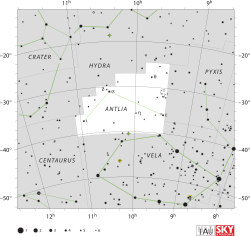Zeta2 Antliae

| |
| Observation data Epoch J2000 Equinox J2000 | |
|---|---|
| Constellation | Antlia |
| Right ascension | 09h 31m 32.15879s[1] |
| Declination | −31° 52′ 18.5989″[1] |
| Apparent magnitude (V) | 5.91[2] |
| Characteristics | |
| Spectral type | A9 IV[3] |
| U−B color index | +0.16[2] |
| B−V color index | +0.23[2] |
| Astrometry | |
| Radial velocity (Rv) | +19.8 ± 1.6[4] km/s |
| Proper motion (μ) | RA: -49.39[1] mas/yr Dec.: -0.82[1] mas/yr |
| Parallax (π) | 8.50 ± 0.36[1] mas |
| Distance | 380 ± 20 ly (118 ± 5 pc) |
| Absolute magnitude (MV) | +0.44[5] |
| Details | |
| Mass | 2.55 M☉ |
| Radius | 4.4 R☉ |
| Luminosity | 61 L☉ |
| Temperature | 7820 K |
| Other designations | |
| Database references | |
| SIMBAD | data |
Zeta2 Antliae is the Bayer designation for a star in the southern constellation of Antlia, the air pump. With an apparent visual magnitude of 5.91,[2] it is a relatively faint star that requires dark suburban skies for viewing with the naked eye. Parallax measurements show it to be located at a distance of roughly 380 light-years (120 parsecs) from Earth.[1]
The spectrum of this star matches a stellar classification of A9 IV,[3] where the luminosity class of IV indicate that this is a subgiant star that is evolving away from the main sequence as the supply of hydrogen at its core is becoming exhausted. This is catalogued as an Am star, which means it is a chemically peculiar star that shows strong indications of certain trace metals in its spectrum.[5] It shines with a luminosity approximately 45 times that of the Sun and has a surface temperature of 7273 K.[7]
References
- 1 2 3 4 5 6 van Leeuwen, F. (November 2007), "Validation of the new Hipparcos reduction", Astronomy and Astrophysics, 474 (2): 653–664, arXiv:0708.1752
 , Bibcode:2007A&A...474..653V, doi:10.1051/0004-6361:20078357.
, Bibcode:2007A&A...474..653V, doi:10.1051/0004-6361:20078357. - 1 2 3 4 Mendoza, E. E.; Gomez, V. T.; Gonzalez, S. (June 1978), "UBVRI photometry of 225 Am stars", The Astronomical Journal, 83: 606–614, Bibcode:1978AJ.....83..606M, doi:10.1086/112242.
- 1 2 Houk, Nancy (1979), Michigan catalogue of two-dimensional spectral types for the HD stars, 3, Ann Arbor, Michigan: Dept. of Astronomy, University of Michigan, Bibcode:1982mcts.book.....H.
- ↑ Gontcharov, G. A. (November 2006), "Pulkovo Compilation of Radial Velocities for 35 495 Hipparcos stars in a common system", Astronomy Letters, 32 (11): 759–771, Bibcode:2006AstL...32..759G, doi:10.1134/S1063773706110065.
- 1 2 Hauck, B.; Curchod, A. (December 1980), "Properties of AM stars in the Geneva photometric system", Astronomy and Astrophysics, 92 (3): 289–295, Bibcode:1980A&A....92..289H.
- ↑ "HR 3789 -- Star", SIMBAD Astronomical Object Database, Centre de Données astronomiques de Strasbourg, retrieved 2012-06-27.
- ↑ McDonald, I.; Zijlstra, A. A.; Boyer, M. L. (2012). "Fundamental Parameters and Infrared Excesses of Hipparcos Stars". Monthly Notices of the Royal Astronomical Society. 427 (1): 343–57. arXiv:1208.2037
 . Bibcode:2012MNRAS.427..343M. doi:10.1111/j.1365-2966.2012.21873.x.
. Bibcode:2012MNRAS.427..343M. doi:10.1111/j.1365-2966.2012.21873.x.